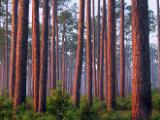Longleaf Pine
In the spring of 1773 William Bartram, a naturalist from Philadelphia, traveled across the Southeast and described "a vast forest of the most stately pine trees that can be imagined.” At that time longleaf pine was the dominant tree across much of the Southeast, and the ecosystem that bears its name covered about 90 million acres. Logging, land development, and other factors have destroyed nearly all of these old-growth pine forests, and today less than 2 million acres of this unique habitat still exist -- a 97% decline that represents one of the most drastic reductions of any of our major natural ecosystems.
What is it?
The Longleaf Pine ecosystem encompasses a variety of natural communities characterized by longleaf pine (Pinus palustris) and a diverse suite of grasses and herbs. The ecosystem once covered most of the uplands across the southeastern coastal plain from Virginia to Texas, with additional stands further inland. The distribution map shown here is based on data related to the historic and current distribution of the species, which is used as a surrogate for the occurrence of Longleaf Pine-dominated communities, but which probably overestimates the current distribution of viable stands due to the coarseness of the data.
Individual longleaf pine trees can live up to 300 years, and they thrive in both even and uneven aged, open stands with a grass-dominated ground layer. These stands are prone to ground fire, which may start from lightning strikes, spreading widely in the flat landscapes of the Coastal Plain. The longleaf pine is specifically adapted to an environment in which extensive fires may occur every few years.
There are many favorable features of a longleaf pine tree’s life cycle that help it in a fire-prone environment. The seeds germinate well on bare soil; especially if they fall where the grasses and pine needle litter has recently burned. One other specific adaptation is the so-called “grass stage” in which the seedlings do not look at all tree-like, but simply appear to be a spreading fountain of needles. In the grass stage, it may get the tips of its needles burned, but the growing bud and stem remain protected. This stage lasts for 5-12 years of slow growth. After this period, it makes a growth spurt, especially if there are no shading trees above.
There are many species of conservation interest in the Longleaf Pine ecosystem, including the well-known Red-cockaded Woodpecker, as well as several amphibians, and reptiles such as the Gopher Tortoise and the Eastern Indigo Snake (which is the largest North American snake), in addition to many rare plants.
The Red-cockaded Woodpecker is an endangered bird which nests in holes in old, but still living longleaf pine trees. These holes or cavities take several years to make, and must be in open pine stands, without a shrubby midstory. An extensive area of similar and contiguous foraging habitat is also necessary for nesting success. The Red-cockaded Woodpecker is a cooperative breeder, living in family groups, sometimes with one or two male helpers. A male helper can potentially inherit a cavity, which is essential for breeding success.
The longleaf pine ecosystem supports high plant diversity. More than 40 species have been documented in a single square meter, and as many as 170 species in 1000 square meters, or ¼ acre. This level of diversity is very high for ecosystems in the temperate United States, and is among the most diverse in North America. Mostly these are herbaceous plants, which are found in combination with native grasses, including Wiregrass in the southern and coastward part of the range, west to Mississippi, and other grasses (such as Little Bluestem, Muhlygrasses, Witchgrasses, and Dropseeds) elsewhere. These grasses provide the fine fuels that carry the fires that are crucial for Longleaf reproduction and survival.
Go Straight to Your State
Learn about conservation and open space in your state.



